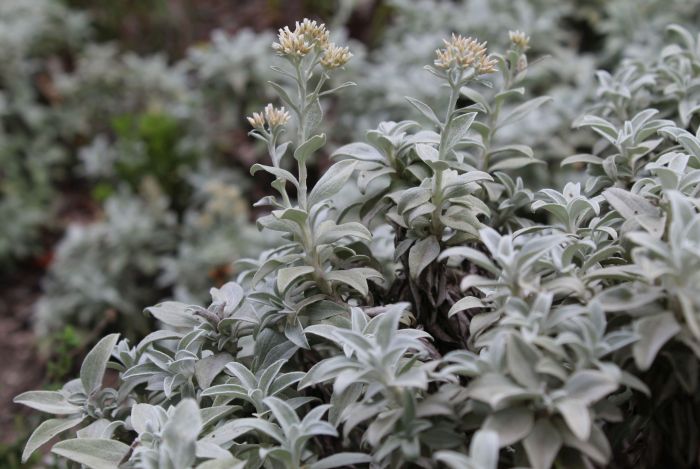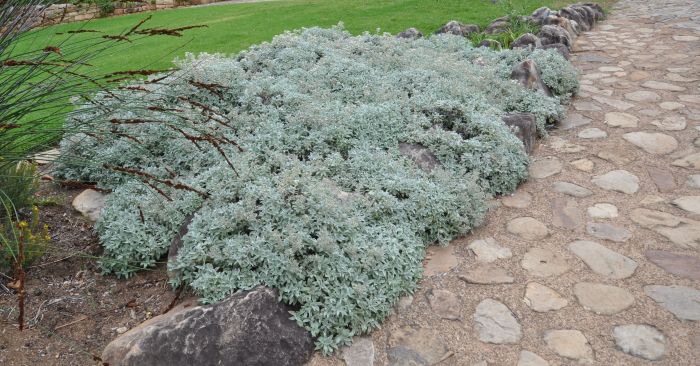Helichrysum sutherlandii
Helichrysum sutherlandii Harv.
Family: Asteraceae
Common names: Sutherland’s everlasting (Eng.); molepelle, ntlo-ea mokhobane, senkotoana (Sesotho)
Introduction
This is an attractive shrublet and an ideal ornamental garden plant because of its grey foliage.

Description
Description
Helichrysum sutherlandii is a well-branched shrublet that grows in clumps, fully developing to a height of 400 mm with a 600 mm spread. The leaves are grey, woolly to hairless above and white-felted below. The inflorescence is also much branched, nearly flat-topped, 20–120 mm wide and held away from the plant. The flowerheads are small, with pale brown outer bracts and milky-white inner bracts, webbed together with wool. The flowers are yellow. The flowering period is in late summer, autumn and early winter, from February to July.

Conservation Status
Status
The conservation status for this plant is Least Concern (LC); it is not threatened.
Distribution and habitat
Distribution description
Plants are common in the Drakensberg, usually found growing in rocky outcrops, hanging from cliffs, often above streams, on Cave Sandstone. In South Africa it is found in the KwaZulu-Natal, Free State and Mpumalanga Provinces and is not endemic to South Africa because it also occurs in Lesotho.

Derivation of name and historical aspects
History
Plants in the genus Helichrysum are commonly called everlastings or straw flowers and belong to the sunflower family (Asteraceae), ranging from annuals and herbs to shrubs. In South Africa there are approximately 244 discovered species of Helichrysum with an estimated 600 species occurring in Africa, Madagascar, Europe, Asia, and Australia.
The name of the genus Helichrysum is derived from the Greek helios, meaning ‘sun’ and chrysos, meaning ‘gold’ in reference to the flowerheads. This species is named after Dr Peter Cormac Sutherland, 1822–1900, who was a doctor, Government geologist in Natal in 1854 and Surveyor-General of Natal in 1856. He sent plants and flowers of H. sutherlandii to the Royal Botanic Gardens at Kew, in London.

Ecology
Ecology
Many butterfly species use the plants as food during the larval phase.
Like most helichrysums, this species has grey foliage and woolly leaves, which help prevent water loss making it a water-wise plant.

Uses
Use
Medicinally it is used to treat cuts in the skin of a sick person. They seem to have an effect on the relief of pain and inflammation. The plant is burnt and it is the powdered ash that comes from the burnt plant material that is used.

Growing Helichrysum sutherlandii
Grow
Helichrysum sutherlandii can be propagated from both cuttings and seed. Propagate from cuttings and apply rooting hormone number 1 to increase chances of rooting of the plant. Cuttings must be planted in a well-drained soil mix in spring (September). Sow seed in spring or early summer in well-drained, sandy soil.
These plants thrive in full sun, requiring little maintenance. They are semi-hardy to frost, need moderate water and well-drained, sandy soil.
They are ideal for a raised bed, rockery or mixed shrubbery and can also be used as a groundcover and are suitable for containers. They have wonderful grey foliage, making them ideal to use as ornamentals.
References
- Foden, W. & Potter, L. 2005. Helichrysum sutherlandii Harv. National Assessment: Red List of South African plants version 2020.1. Accessed on 2021/03/30.
- Latti, I. n.d. Helichrysum sutherlandii. Operation Wildflower. Online. https://operationwildflower.org.za/index.php/albums/helichrysums/helichrysum-sutherlandii-il-4-6614. Accessed 29/03/2021.
- Latti, I. & Wentzel, J. n.d. Helichrysum sutherlandii flowering in the Drakensberg. Operation Wildflower. Online. https://operationwildflower.org.za/index.php/albums/helichrysums/helichrysum-sp-in-the-drakensberg-173. Accessed 29/03/2021.
- Mathekga, A.D. 2001. Antimicrobial activity of Helichrysum species and the isolation of a new phloroglucinol from Helichrysum caespititium. Thesis in part for Doctor of Philosophiae Plant Physiology, University of Pretoria, Pretoria.
- Wildflower Nursery, Helichrysum sutherlandii. https://wildflowernursery.co.za/indigenous-plant-database/helichrysum-sutherlandii/. Accessed 29/03/2021.
Credits
Sisanda Velembo
Kirstenbosch National Botanical Garden
May 2021
Plant Attributes:
Plant Type: Ground Cover, Shrub
SA Distribution: Free State, KwaZulu-Natal, Mpumalanga
Soil type: Sandy, Loam
Flowering season: Late Summer, Autumn, Winter
PH: Acid, Neutral
Flower colour: Brown, White, Yellow
Aspect: Full Sun, Morning Sun (Semi Shade), Afternoon Sun (Semi Shade)
Gardening skill: Average
Special Features:
Horticultural zones










Rate this article
Article well written and informative
Rate this plant
Is this an interesting plant?
Login to add your Comment
Back to topNot registered yet? Click here to register.